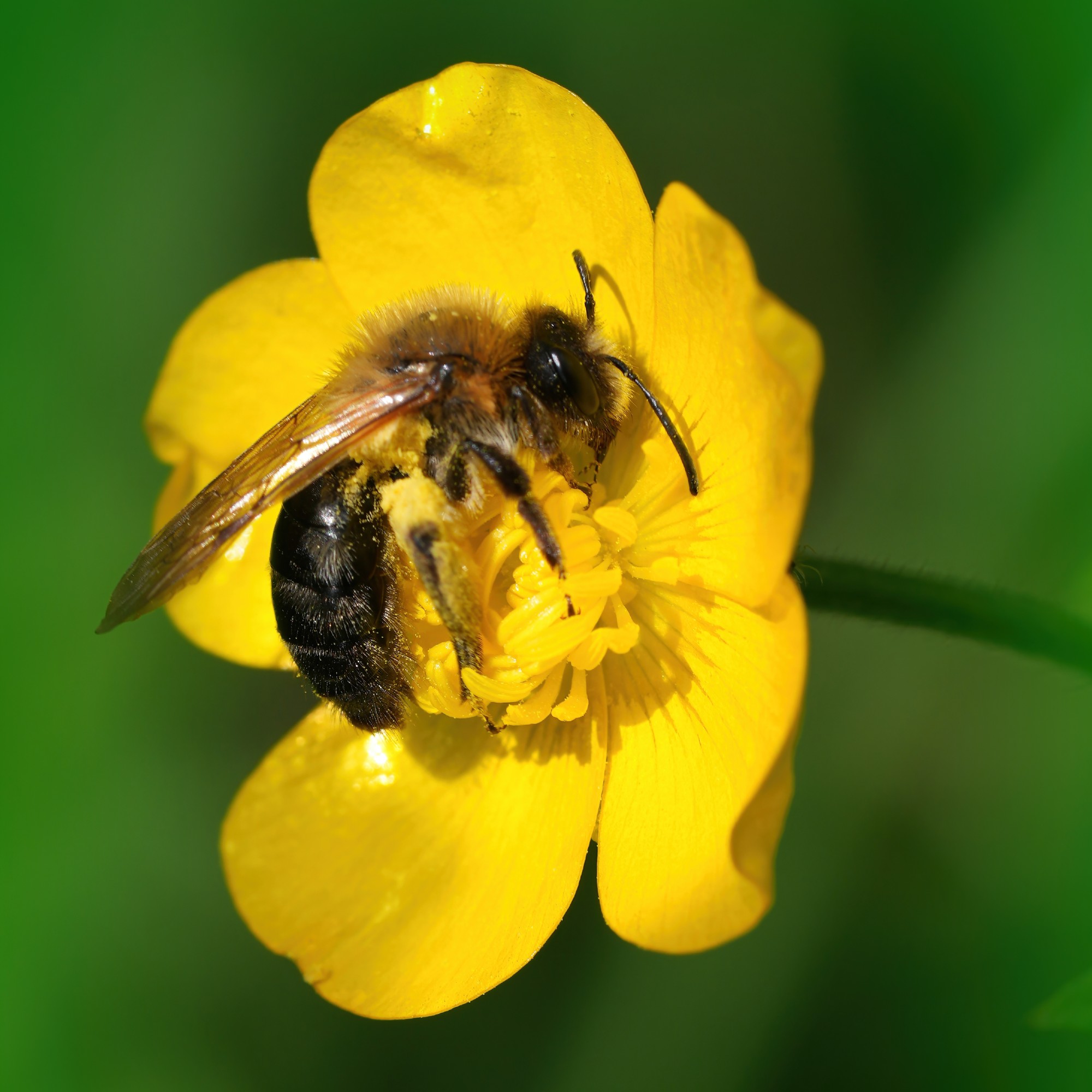Should you get rid of creeping buttercup? Experts weigh in on the pros and cons of keeping this weed in your garden
To weed, or not to weed? We got the advice from experts


- Are there any benefits to keeping creeping buttercup in your garden?
- How do you get rid of creeping buttercup?
- 1. Remove it by hand
- What you'll need
- 2. Aerate your lawn
- 3. Prevent it from the outset
- 4. Last resorts
- FAQs
- What is the difference between buttercup and creeping buttercup?
- Is creeping buttercup good for wildlife?
- Should you get rid of creeping buttercup in a patio?
Creeping buttercup is a tough herbaceous perennial, commonly found in garden lawns and borders. Left to its own devices, it can quickly monopolise parts of a garden – but should you get rid of creeping buttercup?
'Creeping buttercup can appear in even the most well-kept gardens,' says Cheryl Harper, Managing Director of Greensleeves Lawn Care. 'Pets, birds and wildlife can bring it into your garden, or it can even be carried in on the soles of your shoes. It may pop up even after you've triumphed over it before.'
While some might want to remove the plant before it foils their garden ideas, others choose to leave the plant alone as a wildlife garden idea. We asked the experts for their verdict on whether you should get rid of creeping buttercup.

Cheryl Harper is the managing director of Greensleeves Lawn Care.
Established in 1998, Greensleeves Lawn Care is a UK-wide lawn care business with over 100 locations.

Creeping buttercup is widely considered a weed, and it can quickly take over areas of a garden if left to spread.
'Although some people find the flowers pretty, you don’t want to let them take over,' says Cheryl. 'Creeping buttercup is often found in gardens all over the UK. It prefers wet, heavy soils and grows close to the ground.'
If you're wondering how it covers ground so quickly, the answer is in the name. 'Creeping buttercup spreads through your lawn by using seeds and creeping stems which run along the surface of the ground until they reach a suitable place for a new plant,' explains Cheryl.
But why is that a problem? And should you get rid of creeping buttercup?
Sign up to our newsletter for style inspiration, real homes, project and garden advice and shopping know-how
'Creeping buttercup competes with other plants for moisture, nutrients and space,' says Cheryl. 'In lawns, it can steal sunlight and water from your grass, leaving it weak and patchy.
'The plant also has a well-earned reputation for being difficult to remove. It has a deep, dense root system that can be difficult to remove completely. Even small pieces of root left behind can grow into new plants.'

Are there any benefits to keeping creeping buttercup in your garden?
Though they can be a nuisance to us, weeds often provide a host of benefits to the wildlife in our gardens, and this rule applies to creeping buttercup.
'Creeping buttercup is excellent for pollinators,' says Kate Turner, expert horticulturalist at Miracle-Gro. 'It's rich in nectar and pollen and provides food for other insects such as beetles.
'It also works wonderfully well as part of a wildflower meadow garden or lawn and can be grown in a container for pollinators.' So, if you're wondering how to create a meadow in your garden, creeping buttercup might be a good plant to have on side.
In Kate's view, creeping buttercup only becomes a problem if it grows in the wrong place. 'In a formal bed, border, or a pristine lawn, creeping buttercup can outcompete other plants.'

Kate Turner is Miracle-Gro’s expert horticulturalist who has a deep love of all things plants – from vibrant houseplants to stunning gardens and growing fruit and veg, Kate knows all the tips and tricks for successful gardening.

How do you get rid of creeping buttercup?
If you've decided that creeping buttercup is a weed you don't want in your garden, there are several methods you can use to reclaim your space.
1. Remove it by hand
If you've spotted creeping buttercup in a small area of your garden, the quickest and simplest way to get rid of it is removing it by hand.
'For small clusters, the easiest solution is manual removal,' says Cheryl from Greensleeves. 'Use a hand fork or trowel to dig up the entire plant. Make sure to collect any leftover roots and runners as these can sprout again.'
Make sure you know how to clean garden tools to ensure they stay in your kit for as long as possible.
What you'll need

2. Aerate your lawn
If creeping buttercup is cropping up in your lawn, knowing how to aerate your lawn could be key to beating the spread.
'Creeping buttercup thrives in damp, compacted soil,' says Cheryl from Greensleeves. 'Consider aeration if this is a problem with your lawn. Aeration can be a great addition to your summer lawn care routine, and it works by creating channels in the soil, allowing air, water and nutrients to reach the grass roots more easily. This not only helps your lawn thrive, but it also helps it use water more efficiently during hot weather.
'There are two main aeration techniques: hollow tine and spiking. Hollow tine aeration uses a machine to drive hollow spikes into the lawn, which remove small plugs of soil and thatch. The principle of spiking is the same, although it is a less intensive method of aeration.'

3. Prevent it from the outset
According to Cheryl, there are a few tricks to keep up your sleeve if you want to prevent creeping buttercup from getting out of hand in the first place. When fighting most weeds, the key to resilience is keeping your lawn in prime health.
The first involves mowing your lawn right: 'Regularly mow your lawn at a height of 10-25mm and try to mow your lawn once a week. This will help shade the creeping buttercup and prevent it from flowering and setting seed.
'Keep your lawn mower blades sharp and avoid mowing when the grass is wet to ensure a clean cut that promotes healthy growth.'
4. Last resorts
Sometimes, all efforts to eradicate a weed like creeping buttercup can be tried in vain.
As a last resort, you can turn to selective herbicides, says Steve Taylor, technical expert at GreenThumb. 'For larger infestations, consider using a selective herbicide designed for broadleaf weeds. Repeated applications might be necessary, as creeping buttercup is known for its resilience.'
'If you notice widespread creeping buttercup on your lawn, we'd definitely recommend speaking to a professional, like us. We're experts in dealing with unwanted weeds on your lawn and can advise on a proper course of action to ensure your lawn remains lush and healthy.'
Steve Taylor is a distinguished lawn care expert with over 25 years of service at GreenThumb, the UK’s leading lawn treatment service, where he currently excels as the Technical R&D Manager.

FAQs
What is the difference between buttercup and creeping buttercup?
'Buttercup is a broad term that refers to various species within the Ranunculus genus,' explains Steve from GreenThumb. 'Creeping buttercup (Ranunculus repens) is a specific type known for its low-growing, spreading habit and characteristic runners.
'Unlike other buttercup species that may grow upright, creeping buttercup tends to stay close to the ground, making it particularly problematic in lawns.'
Is creeping buttercup good for wildlife?
'Creeping buttercup's bright yellow flowers attract bees, butterflies and other pollinators that feed on its nectar and pollen,' says Cheryl. 'This can be good for your garden, but at its core, it is important to remember that creeping buttercup is a weed, and if left uncontrolled, it can severely impact the health of your lawn.'
Should you get rid of creeping buttercup in a patio?
Creeping buttercup seeds often blow into the cracks of your patio and paving stones- and the results can be detrimental,' says Steven Walley, patio and paving expert from London Stone. 'The unwanted growth can lead to your patio becoming uneven, slippery when it rains, and not to mention it creates an unkempt appearance.
'We always recommend removing creeping buttercup as soon as you see the first signs appear through the cracks of your patio as this will help to prevent it from spreading and creating any further damage to your garden.
'To do this, use a hand fork or trowel to dig out the creeping buttercup, making sure to remove it from the root, and not damage any pointing mortar. If it continues to return, consider spraying a non-chemical weed killer on the affected area.'
Creeping buttercup can be problematic in gardens where it has grown out of hand, or in unwanted areas. If you're leaving it be, or even encouraging it as part of a wilder garden look, the wildlife will be thanking you – but otherwise, the above tips should help you keep it in check.

Sophie joined the Ideal Home team as Gardens Editor in June 2024. After studying English at Royal Holloway, University of London, she began writing for Grow Your Own, which spurred on her love of gardening. She's tried growing almost every vegetable under the sun, and has a soft spot for roses and dinnerplate dahlias.
As Gardens Editor, Sophie's always on the lookout for the latest garden trend. She loves sharing growing hacks for every space, from herbaceous borders to balconies.

